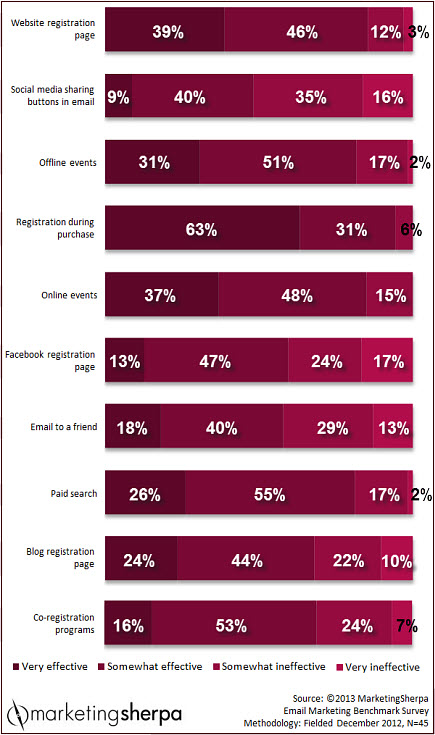by
Daniel Burstein, Director of Editorial Content
"Email is our most effective communications and publicity channel. Maintaining a strict opt-in program has produced good results in our view, but we need to learn more about how to optimize or time our efforts."
The above quote is from an administrative director, and taken from the survey for
the MarketingSherpa 2013 Email Marketing Benchmark Report.
Since we wanted to know how marketers are growing their opt-in lists, the benchmark survey asked:
Q: Please indicate the level of EFFECTIVENESS for each of the email list growth tactics your organization employs.
Click here to see a larger, printable version of this chart
63% of marketers found registration during purchase to be very effective
This continues the trend from our previous Email Marketing Benchmark Report, in which we found
61% of marketers considered registration during purchase very effective.
If you could start, or improve, only one element of your opt-in program this year, you should strongly consider taking a look at how you offer customers the chance to register for your list when they're making a purchase.
Only
41% of marketers are using this tactic to drive their organization's email list growth.
Capturing email addresses during online purchases
When asked about the most difficult email marketing challenge to overcome, one marketer replied, "Capturing email addresses. We're just starting to ask members for their email address as they purchase and renew their membership."
If you're looking to start or optimize your email capture during purchase, here are a few questions to ask yourself and your team:
- Does the way in which we ask for email list sign-up decrease the likelihood that they will purchase a product? For example, forcing potential customers to create an account before purchasing?
- What is the value of signing up for our email list and how can we communicate it? Helpful content? Exclusive discounts?
- Where in the purchase process is the best place to ask for that information? While in the shopping cart? After the purchase is complete, asking for the opt-in on the thank you page?
- How can we make sure the customer understands what they are opting-in to, and that our promotional and content sends are separate from transactional sends? How can we set clear expectations upfront so they don't unsubscribe?
- They may receive a lot of transactional emails from us right after purchase (purchase confirmation, item has been shipped, item has arrived, post-purchase survey, etc.), how do we avoid over-emailing them?
Capturing email addresses during offline purchases
Another response to the question about most difficult challenges was, "Integrating our email platform with our various forms of sales acquisition — call centers, direct mail, webpages, etc. — [and] trying to find a way to automatically import from purchasers into our email platform, and triggering drip campaigns."
This points to a technological challenge. Sometimes, with offline purchases, the easiest way to gain the address is to have it manually entered by your staff after you request it of the customer. Even then, capturing email addresses during non-online purchases can be a challenge as well — but it can be done.
- Physical store: A simple box with a pad of paper and a pen by the register communicating the value of subscribing to the email list.
You can even add an incentive — like a contest or a high-value coupon — for subscribers. Or, go high-tech and allow customers to opt-in using an iPad near the register, like KooKoo Bear Kids did in this case study.
- Call center: During the purchase, offer an additional discount for an email list sign-up. Or, instead, after the purchase, give them the opportunity to stay updated on the latest discounts and content about the type of product they purchased. Just make sure you train your call staff to get accurate email addresses, spelling the address back to the customer to confirm, even knowing to use that "@" symbol instead of spelling out "at."
- Direct mail: Include a field for catalog purchasers to receive exclusive content, additional discounts or whatever of value to your email list.
Perhaps play up the speed by which they will receive that information (for example, a daily deal) as compared to catalogs.
For a complex B2B purchase, this email collection likely happens before the final purchase. For example, MarketingSherpa Email Summit 2014 speaker
Blue Pillar went multichannel — first sending a dimensional mailer, then calling to confirm receipt and at that point asking for email addresses to book executive briefings.
Related Resources
MarketingSherpa Email Summit 2014 — Las Vegas, February 17 through 20Email Marketing: Copyblogger's email list grows by 400% using free paywall to access "MyCopyblogger" contentEmail Marketing: How CNET re-engaged inactive subscribersB2B Content Marketing: Software company increases list 130% with content curation










